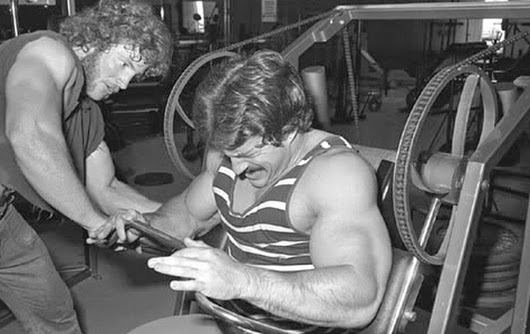Is there any difference in results using free weights vs machines for strength training? You will get wildly varying answers to that question, depending on whom you ask.
Free weights, machines, and skill
Free weights are comprised of barbells, dumbbells, kettle bells, and similar devices. They require some level of training and skill to handle well; in some cases, say learning to curl a dumbbell or barbell, the level of skill needed is minimal; in others, such as performing a heavy squat or deadlift, the practitioner must become very skilled at what he’s doing in order to a) complete the lift and b) do it without injuring himself.
The types of lifting that require the most skill are powerlifting and Olympic weightlifting, since these modes of training and competition actually use barbells.
Strength-training machines use a weight stack or other means of providing resistance, and the weight is manipulated using a cable, bar, or something else, often via pulleys. Machines require little skill to learn, and along with that goes a lower propensity to get injured.
Strength and hypertrophy
Different people have different reasons to train for strength.
Athletes want to become stronger and better skilled at their sport. In the case of weightlifting as a sport, the connection is obvious. In the case of American football and other sports that reward size and strength, greater strength helps them, but skill at, say, squatting a barbell has a less than obvious connection to better football playing.
Bodybuilders want to improve their body composition, and as such aren’t particularly interested in cultivating weightlifting skills, apart from the bodybuilding results they get from them.
Ordinary people, like myself, are interested in both better body composition – more muscle and less fat – as well as the better health that comes with it. Personally, while I enjoy doing deadlifts, whether I use a machine or a barbell to increase my strength and health is a matter of indifference to me – I just want to do what works.
Do strength-training machines work as well as barbells for increasing muscle strength, power, and hypertrophy?
The preponderance of the evidence says that they do, according to Dr. Ralph Carpinelli’s paper on free weights vs machines.

Ralph Carpinelli
The key is that free weights and machines increase strength and hypertrophy in the exercise that’s trained for. For example, from the paper:
The free-weight group showed significantly greater strength gains than the Nautilus group when tested on the equipment used for training: 1RM bench press (24.5 and 15.3%), behind-the-neck press (22.3 and 10.9%), and leg sled (15.5 and 11.2%), for free-weight and Nautilus groups, respectively. The Nautilus group showed significantly greater strength gains than the free-weight group when tested on the Nautilus machines: bench press (47.2 and 23.3%), lateral raise (46.8 and 19.4%), and leg press (28.2 and 17.1%), for the Nautilus and free-weight groups, respectively. Overall, the average strength gain in the free-weight group was 20.4% (Nautilus and free-weight equipment combined), while the Nautilus® group increased 26.6% (Nautilus and free-weight equipment combined).
So, if you want to train for the barbell bench press, or win a bench press competition, you should train with barbells. That’s not to say that training in other ways, such as with machines, might not help you, but it seems clear that to train for specific moves and to develop the skills that go with that move, you should train with that move. Obvious.
What if you don’t care about anything more than training for strength, endurance, and hypertrophy? Then machines should be fine. Muscles don’t know whether they’re pushing against a barbell or a machine.

Mike Mentzer.
Gravity and nature
One disadvantage of barbells is that they can only be used in one direction, up or down, since the force against which the muscles work is gravity. Machines, in contrast, can be arranged such that force can be applied from other directions.
For example, using barbells or dumbbells, rows can only be done by lifting the weight. A rowing machine allows rowing from a seated position. There’s likely less propensity to hurt one’s back using a rowing machine.
Does this matter? Barbell aficionados will tell you that humans are complex, that lifting weights is about more than growing or training muscle, and that the nervous and endocrine systems play a role.
No doubt, humans are complex, but it’s hard to see what barbells have to do with this. To be sure, you develop the skill of the barbell bench press by doing it, but whether that translates into better skill in other areas, or better health, seems debatable.
Behind this argument seems to be that barbells are somehow more natural, and that the human body is more suited to using them, or that because they’re allegedly more natural, they make us healthier or better in some other way.
Lifting a heavy barbell is no more natural than using a machine. Squatting 250 pounds for reps is not a natural movement, and humans did not evolve doing it. Of course, they didn’t evolve using the leg press either.
That’s not to say that free weights and machines are exactly equivalent either. They’re not. Aside from the level of skill, squats exercise muscles differently than does a leg press machine.
Barbell enthusiasts also use the supporting muscle argument, namely that when you, say, perform a squat, you use muscles other than the quads and glutes for support and balance, and thus you train them too. You do, but that doesn’t mean you train them optimally.
Machines and free weights are clearly different, but for increasing strength and hypertrophy, it just depends on which exercise you choose and which muscles you work, not whether you’re using a machine or a barbell.
Personally, I use both. I’m relatively indifferent to developing powerlifting or Olympic lifting skills. I’m in the gym for strength, gains, and health.
Some of the argument about the alleged superiority of free weights reminds me of the argument that learning Latin helps you with English skills. No doubt it does, but learning English better is a lot more direct route to that goal than learning another language. If you want muscle gains, use the most direct route.

Arnold training his back.















7 Comments
I would add the following. I find machines to have many advantages for rehabbing injuries. I am currently rehabbing a hip area issue and the abductor/adductor machine and single-leg leg presses have been very helpful. Single leg hamstring curls were very helpful for a hamstring injury. Many disparage the pec deck contraptions but I find them to be helpful for shoulder stability, and there is no real substitute for a 4-way neck machine.
On the other hand, I think the idea that machines are safer is a misconception. For example, each person has their own path of bar travel in the squat depending on limb lengths and various other things, however the Smith Machine locks you into one path of travel and puts unnecessary stress on the joints, particularly the knees and low back. Same with the leg press. I have found both of these to be very hard on the joints in comparison to free weights. I injured my back on a Smith machine years ago and will never squat with one again. Your muscles may not know the difference between machines and free weights but your joints do.
Hello Mr. PD Mangan,
first of all, thank you for all your articles. Your cut-through-the-bs attitude and articles inspired me to buy a home gym machine that I use a few times times a week. I was and still am mostly uninformed as though what exactly I need, the machine I got is basic and cheap, but for a beginner like me, seems to get the job done.
My machine has a bunch of extensions, hooked up with a wire to weights. It has simple bolt-pivots and round pulley wheels. none of the mechanisms the paper mentions (asymetric cams , etc) to create a variable load. The paper brought up an interesting point regarding VR/CR but throughout the entire paper I couldn’t find anything conclusive and clear about its benefits.
The paper also talks about concentric and eccentric movements and how you need both for proper muscle building, though my machine is probably the cheapest you can find, yet it seems to me (as a novice with some limited research) it does both eccentric and concentric as I first have to get the weight up, and then gently get it down, reversing the movement.
Basically reading these arguments about concentric+eccentric and VR vs CR makes me wonder whether i should upgrade to a better machine.
Finally, after reading this article I thought maybe the paper would be sponsored by Nautilus, but actually reading the paper shows that it includes a ton of different research, and some other brands come up as well; though Nautilus comes up more mainly to them having participated in the research.
The authors’ disclosure at the end helps also. Really interesting paper by the way, the author seems to have done a lot of detective work 🙂 Just like science is supposed to be.
Thank you,
Dieter
Interesting article.
I just know that the squat and deadlift kick your butt in a way that no other lifts (machines or upper body barbell exercises) do. That’s why hardly any guys do them (in most gyms). I don’t know if this kick-your-butt quality translates into real-world strength. The best bodybuilders and strongmen seem to do these lifts.
I have become fascinated with the body weight exercises e.g. the book Convict Conditioning. Herschel Walker is supposed to have gotten very strong by doing bodyweight exercises only. He wrote a book on calisthenics which is now out of print. I like the simplicity, the lower risk of injury and the fact that you don’t have to go to the gym (I hate gyms). I don’t know how bodyweight exercises compare to freeweights or machines). I know if you can do a onearm pushup or pullup (with strict form) you are extremely strong. I still can’t do one good pistol squat even though I’ve been trying for awhile. There are books out there for bodyweight hypertrophy e.g. getting “big” (as opposed to strong
“Lifting a heavy barbell is no more natural than using a machine.”
For one thing, barbells weren’t even around until the mid-late 1800s.
I echo Drifter’s comments on the importance of the path of bar travel. I’ve had some shoulder problems caused by doing machine overhead presses that were in a direction that wasn’t quite right for me.
Cable exercises can be good as you get both time under tension and freedom of path.
P.D,
Came across this today.
https://ergo-log.com/bloodletting-for-bodybuilders.html
healthy aka getting rid of excess iron…
Thanks, good one.